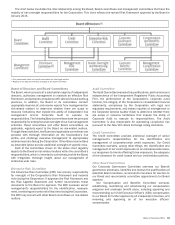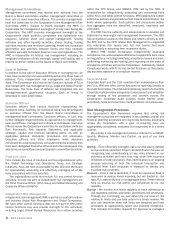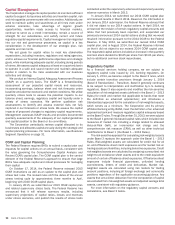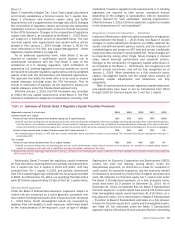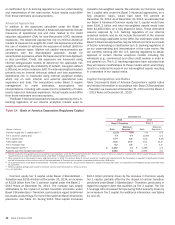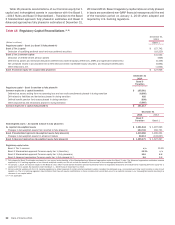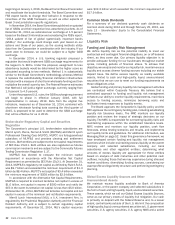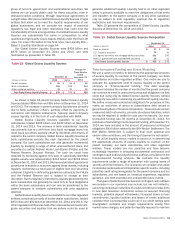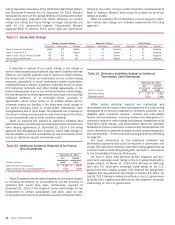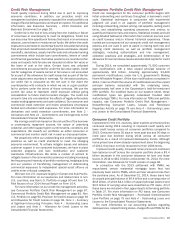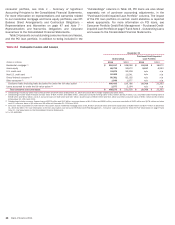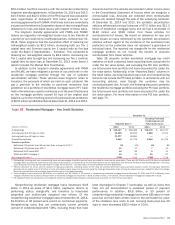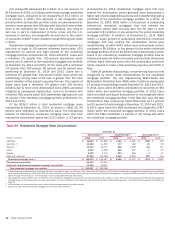Bank of America 2014 Annual Report Download - page 64
Download and view the complete annual report
Please find page 64 of the 2014 Bank of America annual report below. You can navigate through the pages in the report by either clicking on the pages listed below, or by using the keyword search tool below to find specific information within the annual report.62 Bank of America 2014
beginning on January 1, 2016, the Basel Committee will reconsider
and recalibrate the bucket thresholds. The Basel Committee and
FSB expect banks to change their behavior in response to the
incentives of the GSIB framework, as well as other aspects of
Basel 3 and jurisdiction-specific regulations.
In November 2014, the Basel Committee published an updated
list of GSIBs and their respective loss absorbency buckets. As of
December 31, 2014, we estimated our surcharge at 1.5 percent
based on the Basel 3 information and considering the FSB’s report,
“2014 update of list of global systemically important banks
(GSIBs).” Our surcharge could change each year based on our
actions and those of our peers, as the scoring methods utilize
data from the Corporation in combination with the industry. If our
score were to increase, we could be subject to a higher GSIB
surcharge.
In December 2014, a U.S. banking regulator proposed a
regulation that would implement GSIB surcharge requirements for
the largest U.S. BHCs. Under the proposal, assignment to loss
absorbency buckets would be determined by the higher score as
calculated according to two methods. Method 1 is substantially
similar to the Basel Committee’s methodology, whereas Method
2 replaces the substitutability/financial institution infrastructure
indicator with a measure of short-term wholesale funding and then
multiplies the overall score by two. The Federal Reserve estimates
that Method 2 will yield a higher surcharge, currently ranging from
1.0 percent to 4.5 percent.
Under the proposed U.S. rules, the GSIB surcharge requirement
will begin to phase in effective January 2016, with full
implementation in January 2019. Data from the original five
indicators, measured as of December 31, 2014, combined with
short-term wholesale funding data covering the third quarter of
2015, is proposed to be used to determine the GSIB surcharge
that will be effective for us in 2016.
Broker-dealer Regulatory Capital and Securities
Regulation
The Corporation’s principal U.S. broker-dealer subsidiaries are
Merrill Lynch, Pierce, Fenner & Smith (MLPF&S) and Merrill Lynch
Professional Clearing Corp (MLPCC). MLPCC is a fully-guaranteed
subsidiary of MLPF&S and provides clearing and settlement
services. Both entities are subject to the net capital requirements
of SEC Rule 15c3-1. Both entities are also registered as futures
commission merchants and are subject to the Commodity Futures
Trading Commission Regulation 1.17.
MLPF&S has elected to compute the minimum capital
requirement in accordance with the Alternative Net Capital
Requirement as permitted by SEC Rule 15c3-1. At December 31,
2014, MLPF&S’s regulatory net capital as defined by Rule 15c3-1
was $9.7 billion and exceeded the minimum requirement of $1.3
billion by $8.4 billion. MLPCC’s net capital of $3.4 billion exceeded
the minimum requirement of $508 million by $2.9 billion.
In accordance with the Alternative Net Capital Requirements,
MLPF&S is required to maintain tentative net capital in excess of
$1.0 billion, net capital in excess of $500 million and notify the
SEC in the event its tentative net capital is less than $5.0 billion.
At December 31, 2014, MLPF&S had tentative net capital and net
capital in excess of the minimum and notification requirements.
Merrill Lynch International (MLI), a U.K. investment firm, is
regulated by the Prudential Regulation Authority and the Financial
Conduct Authority, and is subject to certain regulatory capital
requirements. At December 31, 2014, MLI’s capital resources
were $32.3 billion which exceeded the minimum requirement of
$17.9 billion.
Common Stock Dividends
For a summary of our declared quarterly cash dividends on
common stock during 2014 and through February 25, 2015, see
Note 13 – Shareholders’ Equity to the Consolidated Financial
Statements.
Liquidity Risk
Funding and Liquidity Risk Management
We define liquidity risk as the potential inability to meet our
contractual and contingent financial obligations, on- or off-balance
sheet, as they come due. Our primary liquidity objective is to
provide adequate funding for our businesses throughout market
cycles, including periods of financial stress. To achieve that
objective, we analyze and monitor our liquidity risk, maintain excess
liquidity and access diverse funding sources including our stable
deposit base. We define excess liquidity as readily available
assets, limited to cash and high-quality, liquid, unencumbered
securities that we can use to meet our funding requirements as
those obligations arise.
Global funding and primary liquidity risk management activities
are centralized within Corporate Treasury. We believe that a
centralized approach to funding and liquidity risk management
enhances our ability to monitor liquidity requirements, maximizes
access to funding sources, minimizes borrowing costs and
facilitates timely responses to liquidity events.
The Board approves the Corporation’s liquidity policy and the
ERC approves the contingency funding plan, including establishing
liquidity risk tolerance levels. The MRC monitors our liquidity
position and reviews the impact of strategic decisions on our
liquidity. The MRC is responsible for overseeing liquidity risks and
maintaining exposures within the established tolerance levels.
MRC reviews and monitors our liquidity position, cash flow
forecasts, stress testing scenarios and results, and implements
our liquidity limits and guidelines. For additional information, see
Managing Risk on page 52. Under this governance framework, we
have developed certain funding and liquidity risk management
practices which include: maintaining excess liquidity at the parent
company and selected subsidiaries, including our bank
subsidiaries and other regulated entities; determining what
amounts of excess liquidity are appropriate for these entities
based on analysis of debt maturities and other potential cash
outflows, including those that we may experience during stressed
market conditions; diversifying funding sources, considering our
asset profile and legal entity structure; and performing contingency
planning.
Global Excess Liquidity Sources and Other
Unencumbered Assets
We maintain excess liquidity available to Bank of America
Corporation, or the parent company and selected subsidiaries in
the form of cash and high-quality, liquid, unencumbered securities.
These assets, which we call our Global Excess Liquidity Sources,
serve as our primary means of liquidity risk mitigation. Our cash
is primarily on deposit with the Federal Reserve and, to a lesser
extent, central banks outside of the U.S. We limit the composition
of high-quality, liquid, unencumbered securities to U.S. government
securities, U.S. agency securities, U.S. agency MBS and a select



